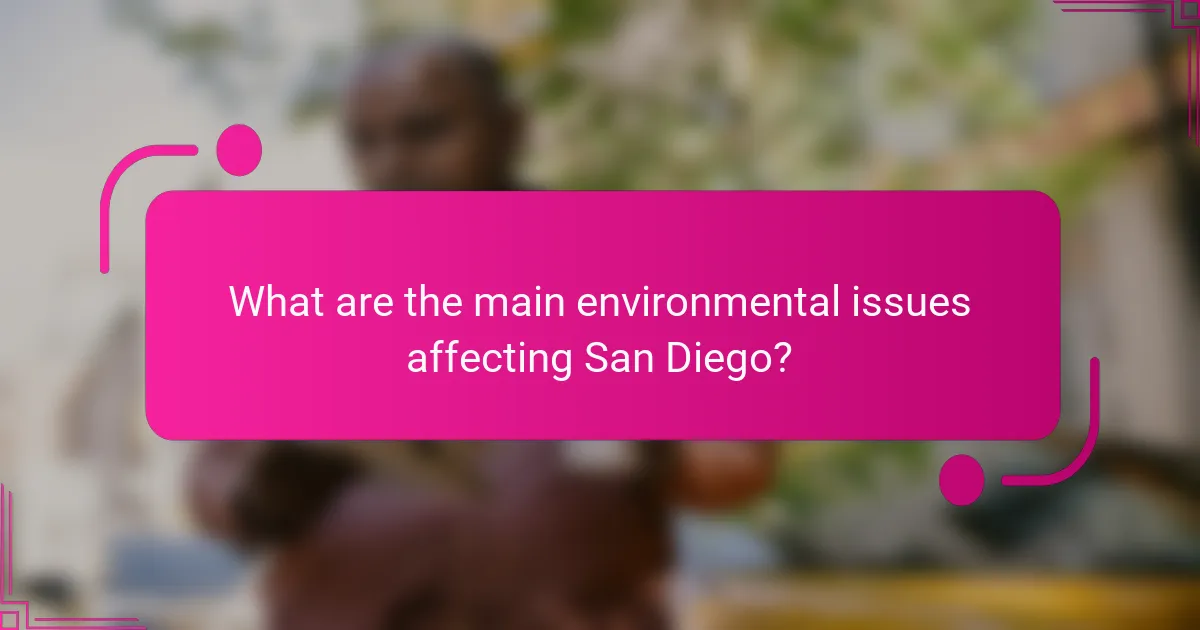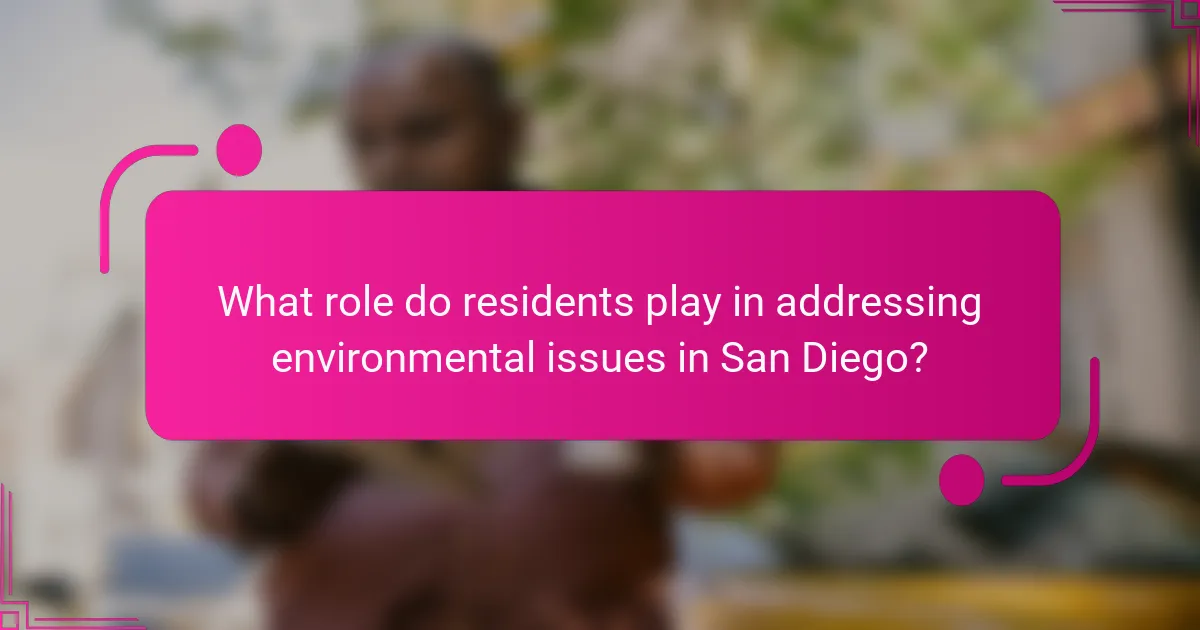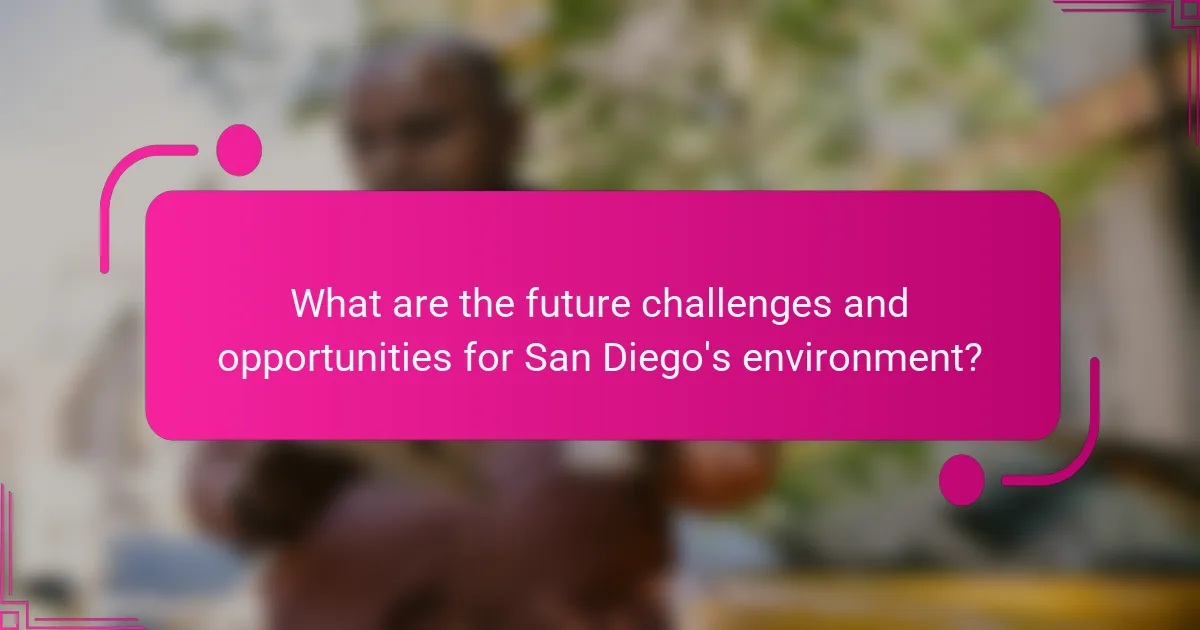
What are the main environmental issues affecting San Diego?
The main environmental issues affecting San Diego include air pollution, water quality degradation, and habitat loss. Air pollution in San Diego is primarily caused by vehicle emissions and industrial activities. According to the California Air Resources Board, San Diego has exceeded federal air quality standards for ozone levels. Water quality degradation results from urban runoff, sewage spills, and agricultural runoff entering local waterways. The San Diego Bay is particularly impacted, leading to harmful algal blooms and reduced marine life. Habitat loss is driven by urban development and climate change, threatening local ecosystems. The San Diego region has lost significant coastal wetlands and native habitats, impacting biodiversity.
How do pollution sources contribute to environmental issues in San Diego?
Pollution sources significantly contribute to environmental issues in San Diego. Major contributors include vehicle emissions, industrial discharges, and agricultural runoff. Vehicle emissions release nitrogen oxides and particulate matter, leading to poor air quality. Industrial discharges can introduce heavy metals and toxins into local waterways. Agricultural runoff often carries pesticides and fertilizers, causing nutrient pollution in coastal areas. These pollutants adversely affect marine ecosystems and public health. According to the San Diego Air Pollution Control District, air quality in the region frequently exceeds federal standards. Additionally, the San Diego Bay has been listed as impaired due to pollutants from various sources.
What types of pollution are most prevalent in San Diego?
Air pollution and water pollution are the most prevalent types of pollution in San Diego. Air pollution primarily comes from vehicle emissions and industrial activities. According to the San Diego Air Pollution Control District, ozone and particulate matter are significant air quality concerns. Water pollution often results from urban runoff and sewage discharge. The San Diego Bay and coastal waters are affected by contaminants from stormwater. These pollution types impact public health and local ecosystems.
What are the primary sources of air pollution in the region?
The primary sources of air pollution in the San Diego region include vehicle emissions, industrial discharges, and wildfires. Vehicle emissions contribute significantly due to the high volume of traffic. Industrial facilities release pollutants during manufacturing processes. Wildfires, especially during dry seasons, produce smoke and particulate matter. According to the San Diego Air Pollution Control District, transportation accounts for about 50% of the region’s air pollution. Additionally, studies indicate that wildfires can lead to spikes in air quality issues, impacting health and visibility.
How does water pollution impact local ecosystems?
Water pollution severely impacts local ecosystems by degrading water quality and harming aquatic life. Contaminants such as heavy metals, nutrients, and pathogens disrupt the balance of aquatic environments. These pollutants can lead to algal blooms, which deplete oxygen levels in the water. Low oxygen conditions can result in fish kills and loss of biodiversity. Polluted water can also accumulate toxins in the food chain, affecting species at various trophic levels. For instance, studies have shown that runoff from urban areas introduces harmful substances into nearby rivers and oceans. This not only threatens wildlife but also affects human health through contaminated water sources. The deterioration of local ecosystems can have long-term consequences on community resources and recreational activities.
What are the effects of pollution on public health in San Diego?
Pollution in San Diego negatively impacts public health. Air pollution contributes to respiratory issues, including asthma and chronic bronchitis. Studies show that high levels of particulate matter increase hospital admissions for respiratory diseases. Water pollution poses risks of gastrointestinal illnesses, particularly from contaminated beaches. The San Diego County Department of Environmental Health reports increased cases of waterborne diseases during heavy rainfall. Furthermore, pollution exacerbates existing health conditions, leading to increased healthcare costs. Vulnerable populations, such as children and the elderly, are particularly at risk. According to the California Air Resources Board, pollution-related health effects disproportionately affect low-income communities.
How does air quality affect respiratory health in the community?
Air quality significantly affects respiratory health in the community. Poor air quality leads to increased rates of asthma and other respiratory diseases. Pollutants such as particulate matter and ozone can irritate the lungs. This irritation can cause inflammation and reduce lung function. Studies show that communities with higher pollution levels experience more respiratory hospitalizations. For instance, research from the California Air Resources Board indicates a direct correlation between air quality and respiratory illness rates. Children and the elderly are particularly vulnerable to these effects. Improved air quality can lead to better overall respiratory health outcomes in the community.
What are the long-term health effects of water contamination?
Long-term health effects of water contamination include chronic diseases and developmental issues. Exposure to contaminated water can lead to gastrointestinal illnesses, reproductive problems, and neurological disorders. Chemicals like lead and mercury can cause lasting damage to organs and the nervous system. Long-term exposure to pathogens can result in persistent infections and weakened immune systems. The World Health Organization states that contaminated water can contribute to over 500,000 deaths annually from diarrheal diseases. Additionally, studies show links between waterborne contaminants and increased cancer risks. Contaminated water can disrupt endocrine functions, affecting hormonal balance and growth. These effects highlight the critical need for clean water access and effective pollution management.
What local responses are being implemented to address these environmental issues?
Local responses in San Diego to address environmental issues include increased recycling programs. The city has implemented a zero waste initiative aiming for 75% waste diversion by 2025. Additionally, local authorities are enhancing public transportation options to reduce vehicle emissions. Community clean-up events are regularly organized to remove litter from beaches and parks. The city has also invested in green infrastructure, such as permeable pavements and urban trees, to manage stormwater runoff. Furthermore, educational campaigns are being conducted to raise awareness about pollution and conservation. These efforts are supported by local legislation aimed at reducing plastic use and promoting sustainable practices.
What initiatives are in place to reduce air pollution in San Diego?
San Diego has implemented several initiatives to reduce air pollution. The city promotes the use of electric vehicles through incentives and charging infrastructure. Additionally, San Diego has adopted stricter emissions standards for vehicles and industrial sources. The city also encourages public transportation and biking to decrease reliance on cars. Programs such as the Climate Action Plan aim to achieve 100% renewable energy by 2035. The Air Pollution Control District monitors air quality and enforces regulations to limit emissions. Community outreach programs educate residents about pollution reduction strategies. These initiatives collectively contribute to improving air quality in the region.
How are local organizations working to combat water pollution?
Local organizations are combating water pollution through various initiatives and programs. They engage in community clean-up events to remove trash from waterways. Organizations also promote awareness campaigns about the effects of pollution on marine life. They implement educational programs in schools to teach students about water conservation. Some groups work with local governments to advocate for stricter pollution regulations. Others monitor water quality and report findings to inform the public. Collaborations with businesses are formed to reduce industrial runoff. These efforts collectively aim to protect and restore local water resources.

What role do residents play in addressing environmental issues in San Diego?
Residents in San Diego play a crucial role in addressing environmental issues. They participate in community clean-up events to reduce litter and pollution. Local advocacy groups mobilize residents to support sustainable practices. Many residents engage in recycling programs to minimize waste. They often attend city council meetings to voice concerns about environmental policies. Additionally, residents can promote conservation efforts in their neighborhoods. Education initiatives help residents understand environmental impacts. Overall, active community involvement leads to positive changes in local environmental health.
How can community engagement improve local environmental conditions?
Community engagement can improve local environmental conditions by fostering collaboration among residents. Engaged communities often organize clean-up events, which directly reduce litter and pollution. Studies show that neighborhoods with active participation see a decrease in waste accumulation. Additionally, community members can advocate for better policies and regulations. This advocacy can lead to stricter environmental protections. Engaged citizens are also more likely to adopt sustainable practices, such as recycling and conservation. Research indicates that areas with high community involvement experience improved air and water quality. Overall, community engagement creates a sense of responsibility and ownership over local environmental issues.
What actions can residents take to reduce their carbon footprint?
Residents can reduce their carbon footprint by adopting several key actions. They can use public transportation, which emits less carbon than individual car travel. Biking or walking for short trips also minimizes emissions. Residents should reduce energy consumption by using energy-efficient appliances and LED lighting.
Switching to renewable energy sources, such as solar panels, significantly lowers carbon output. Reducing water usage also contributes to lower carbon emissions. Composting organic waste decreases methane emissions from landfills. Finally, choosing local and seasonal foods reduces the carbon footprint associated with transportation.
These actions collectively contribute to a more sustainable lifestyle and a healthier environment.
How can local advocacy influence environmental policy?
Local advocacy can significantly influence environmental policy by mobilizing community support and raising awareness. Advocacy groups often engage residents through educational campaigns. These campaigns highlight local environmental issues, such as pollution and habitat destruction. Increased public awareness can lead to greater civic engagement. This engagement often results in public pressure on local government officials. Officials may then prioritize environmental concerns in policymaking. For instance, successful advocacy efforts have led to stricter pollution regulations in various communities. Local advocacy can also facilitate partnerships between citizens and policymakers. These partnerships can create more effective environmental strategies.
What educational resources are available for residents regarding environmental issues?
Residents can access various educational resources regarding environmental issues through local organizations and government initiatives. The San Diego County Environmental Health Department offers workshops and informational materials on pollution and waste management. The San Diego Audubon Society provides programs focused on local wildlife and habitat conservation. Additionally, the city’s website features a dedicated section on sustainability practices, including recycling and energy conservation tips. The California Coastal Commission also hosts educational events aimed at promoting coastal health and environmental stewardship. These resources equip residents with knowledge to better understand and address environmental challenges in their community.
Where can residents find information on pollution and health impacts?
Residents can find information on pollution and health impacts through local government websites. The City of San Diego’s Environmental Services Department provides resources on air quality and pollution levels. Additionally, the California Air Resources Board offers data on statewide air quality trends. The Environmental Protection Agency (EPA) has a dedicated section for health effects of pollutants. Community organizations also publish reports on local pollution issues. These resources offer detailed insights into the effects of pollution on public health. Accessing these platforms will help residents stay informed about environmental conditions.
What programs exist to promote environmental awareness in schools?
Programs that promote environmental awareness in schools include Eco-Schools, Green Schools, and Project Learning Tree. Eco-Schools is a global program that encourages sustainable practices in educational institutions. Green Schools focuses on creating healthy and sustainable learning environments. Project Learning Tree provides educators with resources to teach students about the environment. These programs engage students in hands-on activities and foster a sense of responsibility towards the environment. Research shows that such initiatives lead to increased environmental knowledge and behavior among students.

What are the future challenges and opportunities for San Diego’s environment?
San Diego’s environment faces challenges such as climate change, water scarcity, and habitat loss. Rising temperatures threaten local ecosystems and increase wildfire risks. Water scarcity is exacerbated by population growth and prolonged droughts. Habitat loss occurs due to urban development and land use changes.
However, there are opportunities for San Diego’s environment. Renewable energy initiatives aim to reduce greenhouse gas emissions. Coastal restoration projects can enhance biodiversity and resilience. Community engagement in sustainability practices can foster environmental stewardship.
Investments in green infrastructure may improve urban resilience against climate impacts. These combined efforts can lead to a more sustainable future for San Diego’s environment.
How might climate change impact pollution levels in San Diego?
Climate change may increase pollution levels in San Diego. Rising temperatures can exacerbate ground-level ozone formation. Ozone is a harmful pollutant that affects air quality. Additionally, climate change can lead to more frequent wildfires. Wildfires release particulate matter and other pollutants into the air. Increased rainfall intensity may lead to more runoff, carrying pollutants into water bodies. This runoff can contaminate local waterways and harm marine ecosystems. Moreover, sea-level rise may contribute to coastal flooding, impacting infrastructure and increasing pollution sources. These interconnected effects highlight the potential for worsening pollution levels due to climate change in San Diego.
What are the projected effects of rising sea levels on local ecosystems?
Rising sea levels are projected to significantly impact local ecosystems. Coastal habitats such as wetlands and estuaries may experience increased salinity, leading to shifts in plant and animal species. This change can disrupt food chains and reduce biodiversity. Additionally, submerged habitats may lose their ability to support wildlife. Increased flooding can also lead to erosion, further degrading habitats. According to the National Oceanic and Atmospheric Administration (NOAA), sea levels along the U.S. West Coast are expected to rise by 1 to 2 feet by 2050. This rise poses a threat to critical ecosystems, particularly in areas like San Diego.
How could increased temperatures affect air quality in urban areas?
Increased temperatures can significantly degrade air quality in urban areas. Higher temperatures contribute to the formation of ground-level ozone, a harmful air pollutant. Ozone levels rise as sunlight reacts with pollutants from vehicles and industrial sources. Urban heat islands exacerbate this effect, trapping heat and increasing pollution concentration. Research indicates that for every 1°F rise in temperature, ozone levels can increase by 1-2%. This leads to respiratory issues and exacerbates health problems. Additionally, increased temperatures can enhance particulate matter levels by promoting dust and other particles’ suspension in the air. Overall, rising temperatures pose a serious threat to urban air quality and public health.
What innovative solutions are being explored to tackle these challenges?
Innovative solutions being explored to tackle environmental challenges in San Diego include advanced waste management systems. These systems utilize technology for efficient recycling and composting. Smart sensors are being integrated into waste bins to optimize collection routes. Furthermore, the city is investing in green infrastructure, such as permeable pavements and green roofs. These structures help manage stormwater runoff and reduce urban heat. Additionally, community engagement programs promote sustainable practices among residents. Research shows that these initiatives can significantly decrease pollution levels. Studies indicate that cities implementing such solutions report improved air and water quality.
What role does technology play in monitoring and reducing pollution?
Technology plays a crucial role in monitoring and reducing pollution. It enables real-time data collection through sensors and satellite imagery. These tools help identify pollution sources effectively. For instance, air quality monitoring stations provide continuous updates on pollutants. This data allows for timely responses to pollution incidents. Additionally, technology facilitates the development of cleaner production methods. Innovations like waste-to-energy systems reduce landfill waste and emissions. Furthermore, environmental modeling software predicts pollution dispersion patterns. This information aids in creating targeted regulations and policies. Overall, technology enhances both the monitoring and mitigation of pollution impacts.
How can sustainable practices be integrated into urban planning?
Sustainable practices can be integrated into urban planning by incorporating green infrastructure, promoting mixed-use development, and enhancing public transportation. Green infrastructure includes features like green roofs and permeable pavements. These elements help manage stormwater and reduce urban heat. Mixed-use development encourages walkability and reduces reliance on vehicles. This can lead to lower emissions and improved air quality. Enhancing public transportation provides residents with eco-friendly travel options. Cities that prioritize these practices often see improved community health and environmental outcomes. For example, San Diego has initiated programs to increase urban greenery and public transit accessibility, demonstrating a commitment to sustainability.
What practical steps can residents take to contribute to a healthier environment?
Residents can contribute to a healthier environment by reducing waste and conserving resources. They can practice recycling and composting to minimize landfill contributions. Using reusable bags, bottles, and containers decreases single-use plastic waste. Participating in local clean-up events helps remove litter from public spaces. Residents should also conserve water by fixing leaks and using water-efficient fixtures. Planting native trees and plants supports local ecosystems and improves air quality. Supporting local farmers’ markets reduces carbon footprints associated with transportation. Educating others about environmental issues fosters community awareness and action. These actions collectively contribute to a healthier environment in San Diego.
The main entity of the article is the environmental issues affecting San Diego, specifically focusing on pollution sources, their effects, and local responses. Key environmental concerns include air pollution from vehicle emissions and industrial activities, water quality degradation due to urban runoff and sewage spills, and habitat loss driven by urban development and climate change. The article outlines the significant health impacts of pollution on residents, including respiratory issues and gastrointestinal illnesses, while detailing local initiatives aimed at reducing pollution and promoting sustainability. Furthermore, it highlights the role of community engagement and technology in addressing these environmental challenges and improving local conditions.